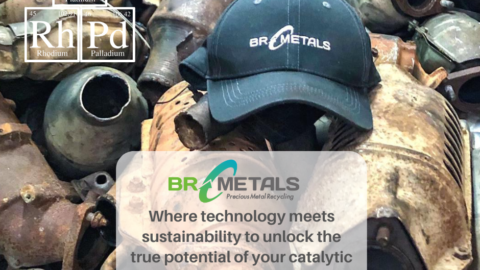The reasons for falling Platinum Group Metals (PGMs) prices, specifically platinum, palladium and rhodium, are complex and multifaceted but one thing is clear: these fluctuations can indeed impact the catalytic converter recycling industry.
Let’s start first by delving into some of the reasons for the decline in PGM prices and their potential effects:
- Market Supply and Demand: If the supply of PGMs exceeds demand, prices fall. This can happen due to increased mining output, reduced industrial demand, or advancements in technology that reduce the amount of PGMs needed for applications like catalytic converters.
- Electric Vehicle (EV) Adoption: A significant portion of PGM demand currently comes from the automotive industry for use in catalytic converters. As the market share of EVs increases and the need for catalytic converters decreases, this could lead to reduced demand for PGMs, causing their prices to drop.
- Technological Advancements: Improvements in catalytic converter technology has led to thrifting to reduce the loading of platinum group metals (rhodium, platinum, or palladium) used in a single auto catalyst to create similar results. Auto manufacturers can also use Selective Reduction Catalysts, which are commercially available and are already fitted to many large vehicles, and thus reducing the demand for new PGMs.
- Investment Dynamics: PGMs are also investment commodities. If investors anticipate a long-term decline in demand due to market changes or a myriad of other factors such as geopolitical events, currency fluctuations, etc, this could influence market sentiment and affect prices independently of current supply and demand dynamics.
- Diversification of PGM Uses: The impact on prices may be mitigated if new uses for PGMs are developed. For example, these metals are also used in various industrial applications, and in emerging technologies like hydrogen fuel cells. Increased adoption in these areas could sustain the demand for PGMs, particularly platinum in the mid to long run.
Will PGM prices go up again? Although it is unlikely to go back to where they were in 2021 to 2022 given the macroeconomic conditions and changing consumer’s preference, prices will very likely stabilise in the foreseeable future.
While governments in many developed countries have set a timeline for fossil fuel ban, the complete switch to EVs will take time, and during this transition, internal combustion engine (ICE) vehicles, including hybrids that use catalytic converters, will remain in use. This ensures a continued, albeit gradually decreasing demand for PGM as well as the supply of catalytic converters for recycling.
Now, let’s look at how falling prices will affect catalytic converter recycling in the short to mid-run.
- Reduced Profit Margins: Pretty obvious… Lower PGM prices lead to smaller profit margins for recycling companies. If you are thinking about getting that machine or invest in new technologies to reduce operating costs, now will be a good time to do so.
- Diversification: For companies that are focused on trading or recycling catalytic converters alone, consider focusing on volume and payment by assay or taking on other valuable materials. At BR Metals, we are now offering precious metals recycling services, including GOLD and SILVER recycling as well as different types of PGM scraps. Find out more here and here
- Long-term Contracts and Hedging: To minimise the impact of fluctuating PGM prices, it’s best engage in long-term contracts or hedging strategies. BR Metals helps our long-time customers hedge their precious metals 2 weeks before their materials arrive at our facility in Singapore
- Technological Innovation: If you are determined to stay for the long haul and aren’t deterred by lower profitability, consider investing in new recycling technologies to make the process more efficient and cost-effective.
So, to sum up, while falling PGM prices can pose challenges to the catalytic converter recycling business, factors like ongoing demand for PGMs, environmental considerations, and the potential for technological and business model innovations can help sustain the business for the long run. We have to adapt and diversify to stay in this business, and there’s no better time than now to do so.






